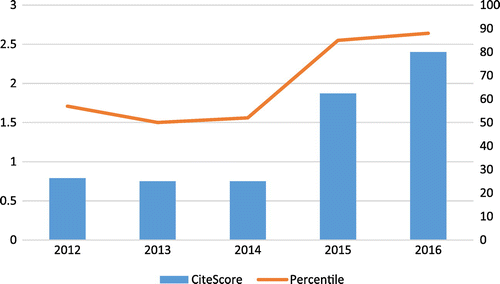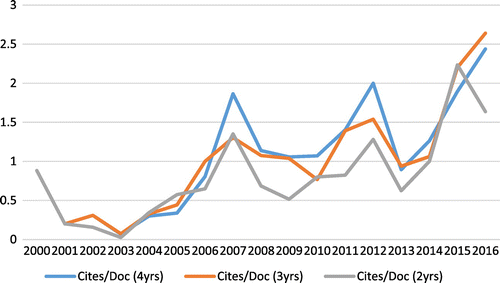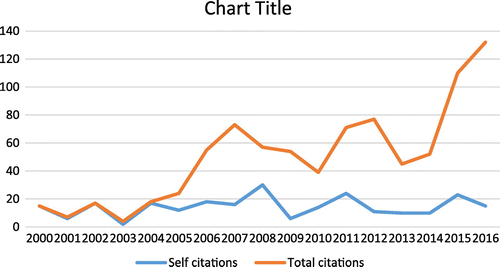As we approach 20 years of publishing Venture Capital: An International Journal of Entrepreneurial Finance it is appropriate to review the current status and impact of the journal. When launched in 1999, the journal had four aims (Mason and Harrison Citation1999): to raise the profile of entrepreneurial finance as a field of academic discourse commensurate with its role in innovation, wealth creation and employment generation; to reflect the expansion of entrepreneurial finance as an academic field; to provide a focus for the hitherto widely dispersed academic literature on the topic; and to provide a forum for the exchange of views between academic researchers and practitioners.
To achieve these aims, it is important that the journal has developed prestige and status as an authoritative source of the latest and highest quality of academic research on entrepreneurial finance. It is, of course, widely recognised that not all scientific documents, most specifically refereed journal articles, have the same value and that not all academic journals are equally prestigious. To the extent to which the value of a paper is represented by the status of the journal in which it is published (but see Mingers and Yang Citation2016; Pidd and Broadbent Citation2015; Starbuck Citation2005 on the ecological fallacy) citations have been increasingly seen as recognition of foregoing worth (Garfield Citation1988). The first substantive attempt to use citation counts to objectively quantify the impact of scientific journals was the Impact Factor, now in use for over 50 years (Garfield Citation2006) and represented by the impact factor rankings provided in the Journal Citation Reports (JCR™) database by Thompson Reuters (now Clarivate Analytics).
This measure, though widely used, has, however, been criticised on the basis that there are considerable variations in citation cultures, rates and practices across disciplines and fields (Guerrero-Bote and Moya-Anegón Citation2012). It is also argued that the journal impact factor represents more a popularity index than a measure of prestige per se (Bonacich Citation1987), which was the original intent, because it does not make allowance for differences in the value of documents and journals. Simply put, a journal gains prestige by being cited by a prestigious journal rather than a less prestigious one and by a journal in the same field rather than one in a non-cognate field: the source of citations therefore matters. In response to this a number of alternative measures have recently been developed, based on the ScopusTM database as the world’s largest scientific database covering most of the journals included in the JCRTM database and more besides (Leydesdorff, Moya-Anegón, and Guerrero-Bote Citation2010; Moya-Anegón et al. Citation2007).Footnote1 We report on three of these measures as they pertain to Venture Capital: An International Journal of Entrepreneurial Finance.
SCImago Journal Rank (SJR)
First, the SCImago Journal Rank (SJR) measures the weighted citations received by a journal, where the citation weighting depends on subject field and prestige (SJR) of the citing journal. Based on the Scopus database, the SJR is a size-independent prestige indicator that ranks journals by their average prestige per article. It is based on the idea that all citations are not created equal. As such, SJR is a measure of the scientific influence of journals that accounts for both the number of citations received by a journal and the importance or prestige of the journals where such citations come from. In so doing, it measures the scientific influence of the average article in a journal and expresses how central to the global scientific discussion an average article of the journal is (definition taken from https://www.scimagojr.com).
This measure has been shown to be highly correlated with the JCRTM impact factor across a number of disciplines (Jacsó Citation2010; Mahmood and Almas Citation2016; Sicilia, Sánchez-Alonso, and García-Barriocanal Citation2011). However, while at first sight these metrics appear highly correlated, these correlations mask some significant differences between them, both theoretically and empirically, which can have a major impact on the rankings of individual journals. (Mingers and Yang Citation2016). As a result, some caveats have to be borne in mind in using and interpreting such measures: first, as citation data are always highly skewed there is a question mark over the validity of measures based on parameters such as the mean; second, there is the ecological fallacy of making judgements about, for example, the quality of individual papers on the basis of whole population characteristics, such as the quality of the journal they are published in; and third, for the social sciences in particular, there is the broader issue of the appropriateness of using citation data, especially in the form of short-term impact factors, as a measure of journal quality at all (Mingers and Yang Citation2016).
Over the past five years the performance of Venture Capital: An International Journal of Entrepreneurial Finance on the SCR measure has improved markedly and in terms of impact factor ranks in or close to the top quartile for journals in the Finance category (Table ).
Table 1. SCImago Journal Rank (SJR) and Source Normalised Impact per Paper (SNIP) 2012–2016 for Venture Capital.
Source Normalised Impact per Paper (SNIP)
This measures actual citations received relative to citations expected for the journal’s subject field. Specifically, this indicator measures the average citation impact of the publications of a journal. Unlike the well-known journal impact factor, SNIP corrects for differences in citation practices between scientific fields, thereby allowing for more accurate between-field comparisons of citation impact (Moed Citation2010; Waltman et al. Citation2013). The main differences between the SNIP indicator and the journal impact factor are that SNIP is based on Scopus, not Web of Science, corrects for field differences, is based on three rather than two years of cited publications, and counts only citations from selected sources and selected document types (articles, conference papers and reviews, as classified in Scopus). Although not perfect, SNIP has been judged the most useful and unproblematic of the available impact factors for business and management journals (Mingers and Yang Citation2016).
As Table shows, the SNIP indicator for Venture Capital has been rising consistently over the past five years, to 1.228 in 2006, and the journal now ranks 51st in the Finance category, up from a low of 116th four years ago. This clearly indicates the increasing impact of the journal as reflected in citations to the papers published in it.
CiteScore
CiteScore is a recently introduced measure of the average citations received per document published in a journal (Zijlstra and McCullough Citation2016). CiteScore is essentially the average citations per document that a title receives over a three-year period. CiteScore metrics calculate the citations from all documents in year one to all documents published in the prior three years for a title. This offers a more robust and accurate indication of a journal’s impact.
Over the past five years there has been a very sharp increase in both relative and absolute terms in citations to the journal, as recorded in Scopus (Figure ): the CiteScore has risen to 2.40 in 2016, placing the journal at the 88th percentile in the Finance category, and the journal is ranked 25 out of 216 journals in the category (Table ). As an intrinsic indicator of the standing of the journal this suggests that Venture Capital is increasingly being seen as the source of informative and citable research on entrepreneurial finance, and with increasing standing and visibility within its subject category (Finance).
Table 2. Ranking of Venture Capital on CiteScore.
Figure shows in more detail the number of citations received by documents from the journal divided by the total number of documents published in it. The chart shows the evolution of the average number of times documents published in a journal in the past two, three and four years have been cited in the current year. The two years line is equivalent to the journal impact factor metric. While there are year-to-year fluctuations, as would be expected in a small specialised niche journal, the trend is very clearly upward. That this is not due to increased levels of self-citation is clear from Figure , which shows for Venture Capital the evolution of the total number of citations and the journal’s self-citations received by papers published in the journal during the three previous years, where journal self-citation is defined as the number of citations from a journal citing article to articles published by the same journal. In other words, the improvement of the position of Venture Capital on this measure is entirely due to increasing citations in other journals.
Conclusion
Venture Capital: An International Journal of Entrepreneurial Finance has established itself as a leading outlet for the dissemination of research on the risk capital market undertaken from a range of disciplinary and methodological perspectives. While all journal ranking and impact measures are imperfect, and are subject to greater fluctuation the smaller the journal in terms of the number of papers published annually,Footnote2 the Scopus-based analyses presented here confirm a significant recent sharp rise in the standing of the journal. In this paper, we have reviewed the prestige and impact of Venture Capital: An International Journal of Entrepreneurial Finance using a series of impact factors derived from the Scopus database. Whether measured in terms of journal rank (SJR; SNIP), or citation data, the performance of the journal has improved significantly in recent years, entering the top quartile in its category (Finance) in 2015 based on its SJR, ranking 51st (up from 116th in four years) based on SNIP, and ranking 25th out of 216 journals (88th percentile) by citations in 2016. Increasingly, therefore, the journal is meeting its original aims of providing a high quality and visible outlet for academic research on venture capital and entrepreneurial finance. As the journal enters its 20th year of publication we look forward to the continued rise in the standing and impact of the journal, based as it is on the submission, review and publication of high quality international research which reflects the efforts of our authors, editorial board members and ad hoc reviewers in the service of our readers.
University of Edinburgh Business School, Edinburgh, UK
[email protected]
Notes
1. According to the Scopus website it is the “largest abstract and citation database of peer-reviewed literature and quality web sources with smart tools to track, analyze and visualize research” and is more international in coverage than Web of Science.
2. “A journal’s impact factor can change a great deal from year to year and the smaller the journal is, the more variable its impact factor is likely to be. This is because small changes in the absolute number of citations received have a much larger effect on the average number of citations when the denominator (number of articles) is small. For example, we can consider the effect of publishing an article which receives five citations, on two theoretical journals with an impact factor of 1.000, one publishing 25 articles a year and the other 100 articles a year. In the small journal this will improve the impact factor by 0.100 (5/(2 × 25), which is a 10% improvement. In the large journal, however, this would only lead to an improvement of 0.025 (5/(2 × 100) which is only a 2.5% improvement” – see https://journalauthors.tandf.co.uk/beyondpublication/impactfactors.asp#link8 (Accessed 28 June 2017).
References
- Bonacich, P. 1987. “Power and Centrality: A Family of Measures.” American Journal of Sociology 92: 1170–1182.10.1086/228631
- Garfield E. 1988. “Can Researchers Bank on Citation Analysis?” Essays of an Information Scientist: Science Literacy, Policy, Evaluation, and other Essays 11: 354. also in Current Contents, 44, 3–12, October 31, 1988. Accessed June 27, 2017. https://www.garfield.library.upenn.edu/essays/v11p354y1988.pdf
- Garfield, E. 2006. “The History and Meaning of the Journal Impact Factor.” Journal of the American Medical Association 295 (1): 90–93.10.1001/jama.295.1.90
- Guerrero-Bote, V. P., and F. Moya-Anegón. 2012. “A Further Step Forward in Measuring Journals’ Scientific Prestige: The SJR2 Indicator.” Journal of Informetrics 6 (4): 674–688.10.1016/j.joi.2012.07.001
- Jacsó, P. 2010. “Comparison of Journal Impact Rankings in the SCImago Journal & Country Rank and the Journal Citation Reports databases.” Online Information Review 34: 642–657.10.1108/14684521011073034
- Leydesdorff, L., F. Moya-Anegón, and V. P. Guerrero-Bote. 2010. “Journal Maps on the Basis of Scopus data: A Comparison with the Journal Citation Reports of the ISI.” Journal of the American Society for Information Science and Technology 61 (2): 352–369.
- Mahmood K., and K. Almas. 2016. “SCImago Journal Rank Indicator: A Viable Alternative to Journal Impact Factor for Dental Journals.” Libres 26: 144–151.
- Mason, C. M., and R. T. Harrison. 1999. “Editorial: Venture Capital: Rationale, Aims and Scope.” Venture Capital: An International Journal of Entrepreneurial Finance 1: 1–46.10.1080/136910699295974
- Mingers J and L. Yang. 2016 Evaluating Journal Quality: A Review of Journal Citation Indicators and Ranking in Business and Management. Accessed June 27, 2017. https://arxiv.org/pdf/1604.06685
- Moed, H. F. 2010. “Measuring Contextual Citation Impact of Scientific Journals.” Journal of Informetrics 4: 265–277.10.1016/j.joi.2010.01.002
- Moya-Anegón, F., Z. Chinchilla-Rodríguez, B. Vargas-Quesada, E. Corera-Álvarez, F. J. Munoz-Fernández, A. González-Molina, and V. Herrero-Solana. 2007. “Coverage Analysis of Scopus: A Journal Metric Approach.” Scientometrics 73 (1): 53–78.10.1007/s11192-007-1681-4
- Pidd, M., and J. Broadbent. 2015. “Business and Management Studies in the 2014 Research Excellence Framework.” British Journal of Management 26: 569–581.10.1111/1467-8551.12122
- Sicilia, M.-A., S. Sánchez-Alonso, and E. García-Barriocanal. 2011. “Comparing Impact Factors from Two Different Citation Databases: The Case of Computer Science.” Journal of Informetrics 5: 698–704.10.1016/j.joi.2011.01.007
- Starbuck, W. H. 2005. “How Much Better are the Most-prestigious Journals?” The statistics of academic publication, Organization Science 16: 180–200.10.1287/orsc.1040.0107
- Waltman, L., N. J. van Eck, T. N. van Leeuwen, and M. S. Visser. 2013. “Some Modifications to the SNIP Journal Impact Indicator.” Journal of Informetrics 7: 272–285.10.1016/j.joi.2012.11.011
- Zijlstra H, and R. McCullough. 2016. CiteScore: A New Metric to Help You Track Journal Performance and Make Decisions. Accessed June 27, 2017. https://www.elsevier.com/editors-update/story/journal-metrics/citescore-a-new-metric-to-help-you-choose-the-right-journal



